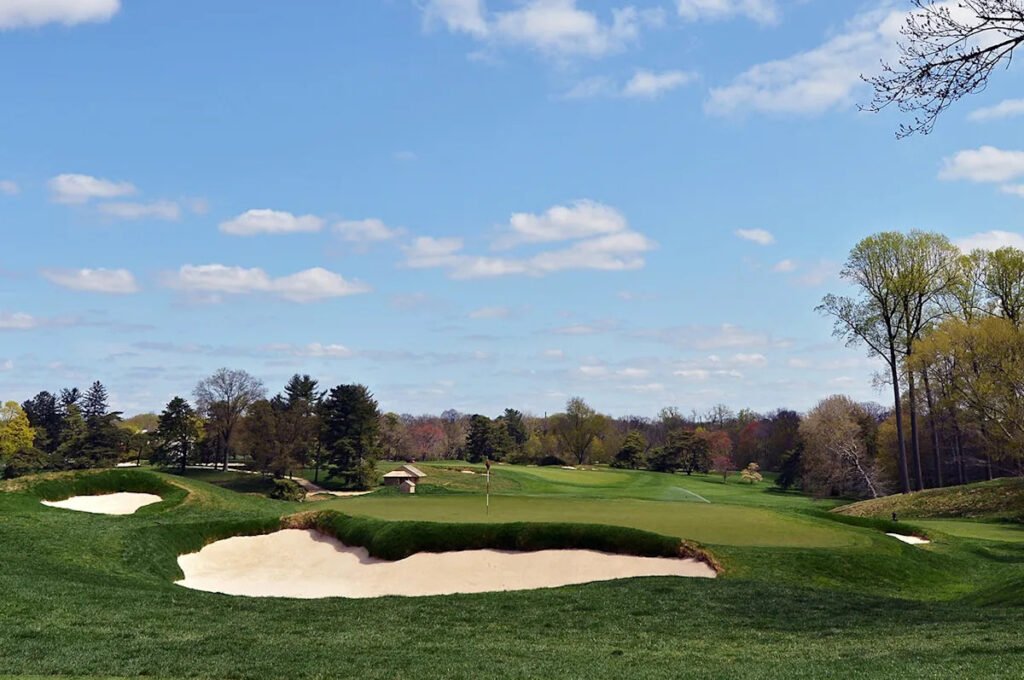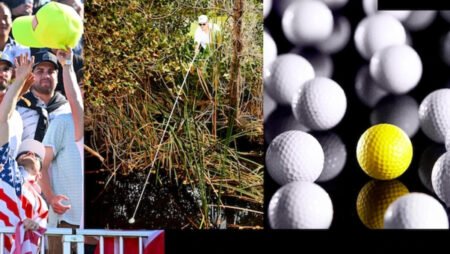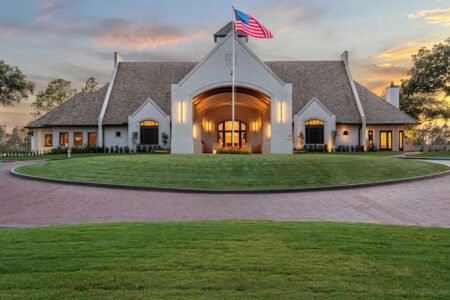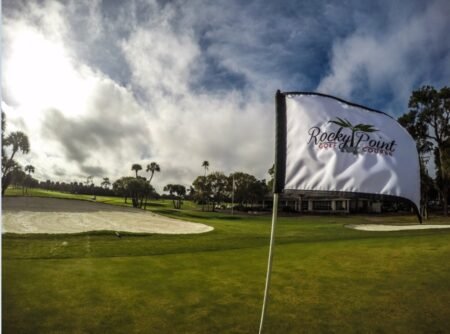Looking at any list of top courses in the world, you will note the sheer beauty of the landscapes on which many of the courses reside and the likelihood they sit on sandy soils. Cypress Point in California weaves through dunes and forests. Along the Northern Irish coast, Royal County Down offers massive dunes, sea views and mountain backdrops. Pine Valley in New Jersey tacks through a sand-scaped pine forest.
Unlike those titans of golf, little Merion Golf Club’s East Course occupies just 117 acres of clay in the Philadelphia suburb of Ardmore.
No. 9 on the East Course at Merion Golf Club in Ardmore, Pennsylvania
The course opened in 1912 and was designed by Hugh Wilson. He was a green committee member of the club designing his first course, and as such he sought council from noted designer Charles Blair Macdonald and agronomy council from early turf researchers Dr. Charles Piper and Dr. Russell Oakley in Washington. Wilson would continue to refine the course, including significant changes made when more land became available, until his death at the age of 45 in 1925.
Advertisement
The club has hosted 19 USGA championships including six U.S. Amateurs, five U.S. Opens and four U.S. Women’s Amateurs. In 1930 Bobby Jones won the U.S. Amateur to complete his Grand Slam on the 11th hole at Merion. The club is slated to host the 2030, 2040 and 2050 U.S. Opens as well as the 2034 and 2046 U.S. Women’s Opens.
Perhaps the most famous photo in championship golf is Hy Peskin’s shot of Ben Hogan’s 1-iron approach to No. 18 in winning the 1950 U.S. Open. And of course, Merion is known for its unique wicker baskets instead of flags – dark red on the front nine (the same color as turf equipment maker Toro) and orangy red on the back (the same color as turf equipment maker Jacobsen).
All told, Merion is a charming and demanding course that, despite the land upon which it sits, is every bit the equal of the game’s best layouts.
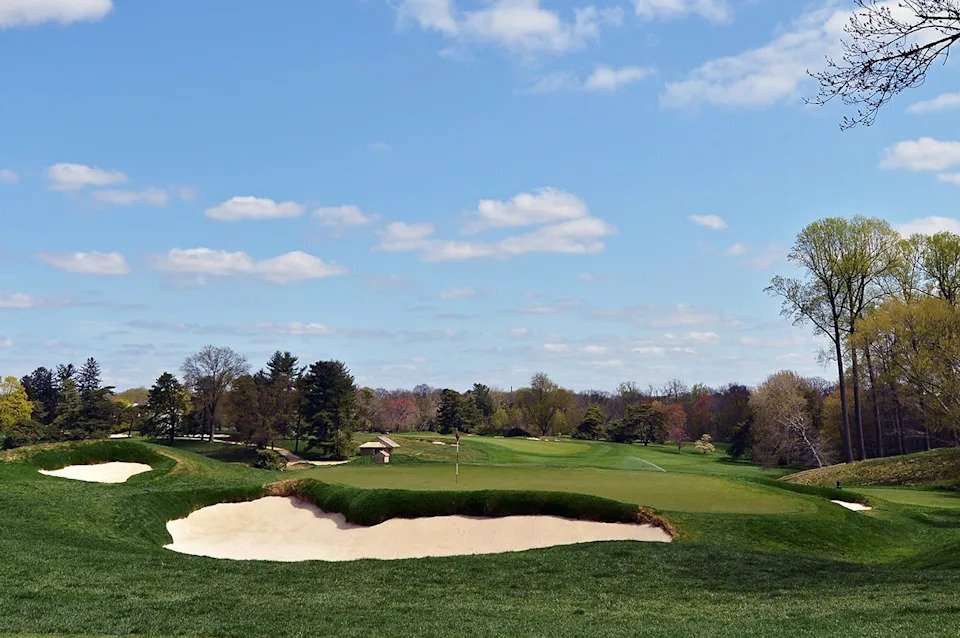
No. 8 on the East Course at Merion Golf Club in Ardmore, Pennsylvania
Following is how I judge Merion in the 10 categories Golfweek’s Best course-ranking program uses to rate courses. Each of the categories is judged on a 10-point scale, then a non-cumulative overall rating is assigned. Overall, Merion is ranked by Golfweek’s Best to be the No. 7 classic course in the United States.
Advertisement
Routing of Merion’s East Course: 10
How well the holes individually and collectively adhere to the land and to each other.
I judge a routing by how much it got out of the property, and the East’s routing maximized the potential of this tiny property. It has a wonderfully interesting rhythm with a difficult start, easy middle and brutal finish. It brilliantly incorporates the quarry, creeks, rolling terrain and more. And it creatively navigates numerous constraints: 117-acre site, road crossings, low wet areas and pinching boundaries.
Integrity of design: 8
The extent to which the existing holes either conform to the original design intent or, for those courses that have been renovated, the extent to which the holes embody a character that is cohesive rather than fragmentary.
Advertisement
Perhaps no course has been more scrutinized from a historical perspective. A recent Gil Hanse restoration aimed to have the features accurately reflect their roots while allowing for modern infrastructure.
Overall Land Plan: 7
Ease of integration of all built-out elements with native land, including course, clubhouse, real estate, roads, and native topography, and landforms. Extent to which the land plan facilitates long views of surrounds and/or interior views of property.
The prominence of Ardmore Avenue bisecting the site was unavoidable yet remains unfortunate. The clubhouse is thankfully at the edge of the site, and the layout with the patio touching the first tee is fantastic. The range is away from the course, which benefits the course but makes for an awkward commute through parking and maintenance.
Advertisement
Greens and surrounds: 8
Interest, variety and playability of putting surfaces, collars, chipping areas and greenside bunkers.
Approach shots at Merion must be precise, as there are creeks, bunkers, deep rough and other elements just a foot off the greens. The greens range from 4,000-10,000 square feet, but each fits its setting beautifully.
Variety and memorability of the par 3s: 9
Differentiation of holes by length, club required, topography, look and angle of approach.
No. 3 is a beast that can be stretched to 275 yards to a plateaued green. No. 9 plays downhill to a green with water in front and a back-left hole location guarded by bunkers. The 13th is a little wedge shot over a high flashed bunker near the clubhouse and entry. No. 17 is played downhill over a quarry into an amphitheater setting. They offer great variety and lots of flexibility for setup.
Advertisement
Variety and memorability of the par 4s: 9
Range of right-to-left and left-to-right drives and second shots required, as well as spread of length, topography and look of the holes.
A superb mix of short and long holes. Nos. 1, 7, 8, 10, 11 and 12 are all shorter with out of bounds, deep bunkers, creeks and elevation as the defense. Nos. 5, 6, 14, 16 and 18 all play long. The fifth offers a severely canted fairway from right to left with a creek down the left, and the approach to 16 is played over a quarry – both are all-world par 4s.
Variety and memorability of the par 5s: 6
Variety of risk/reward opportunities on tee shot; how interesting the second shots are; variety of third shots required.
Advertisement
There are only two par 5s, and both come in the first four holes. No. 2 stretches to 580 yards with Ardmore Avenue as OB down the right. The hole climbs gently uphill to a well-guarded green. No. 4 can be stretched to 635 yards with a tee shot played over the crest of a hill. The green is fronted by a creek and guarded by bunkers long.
Tree and landscape management: 8
Extent to which ornamentals, hardwoods, conifers and other flora enhance the design and playability of a course without overburdening it or compromising strategic flexibility and agronomy.
The small parkland property has clumps of trees that provide shade and ambiance without impacting play. The tee shot on No. 10 is played through a chute of trees that makes turf quality tricky.
Advertisement
Conditioning and ecology: 9
Overall quality of maintenance, discounting for short-term issues (weather or top-dressing); extent of native areas; diversity of plant life and wildlife.
Director of grounds operations Paul Latshaw and his team present championship conditions on a daily basis. The fairways are tight, the approaches are even tighter and the rough is healthy. The course looks green and plays firm.
“Walk in the Park” test: 10
The sense of the place as worthy of spending four hours on it.
Everything about Merion just feels special. The wicker basket flagsticks, the U.S. Open history, the stately clubhouse, the patio on the edge of the first tee and the Jones plaque on No. 11 all make you feel as if you are in a museum. The golf course and the shots you play are equally special.
Advertisement
Overall rating: 9.2
Non-cumulative on a 10-point basis.
In my opinion, Merion’s East is the best golf course on a mediocre site in the world. Not bad for a first-time designer in Hugh Wilson. Chalk full of history and charm, a walk around Merion is a day you will never forget.
This article originally appeared on Golfweek: Golf architect shares notes on what makes Merion’s East Course special
Read the full article here





